
Mulching is incredibly important for the growth and health of your tomato plants. It’s also super simple to do and comes with a wide range of benefits. Unfortunately, despite the wonders of mulching, many tomato gardeners overlook the practice.
Once you discover how easy, cheap, and quick it is to mulch your tomato plants with these five organic mulches available around your home, you’ll have no excuse to skip it this season.
Why Mulch Your Tomato Plants?
When you’re growing thirsty tomato plants, mulch will become your best friend.
That’s because its main purpose is to retain moisture in the soil by keeping it cool and away from direct sunlight. The soil will soak up more water, and it won’t evaporate as quickly, increasing the time between watering and giving your plants consistent access to what they need.
But moisture retention is not the only benefit of mulching.
Many gardeners choose to mulch solely to avoid the hassle of weeding. A thick layer of any mulch will prevent some of those pesky seeds from germinating. Plus, any weeds that do manage to get through will be easier to pull.
Mulches also act as a soil insulator, keeping the soil cool on extremely hot days and warmer earlier and later in the season. We know tomato plants can be fussy about the weather from time to time and react negatively to changes in temperature. Mulching regulates the soil temperature to limit those outbursts.
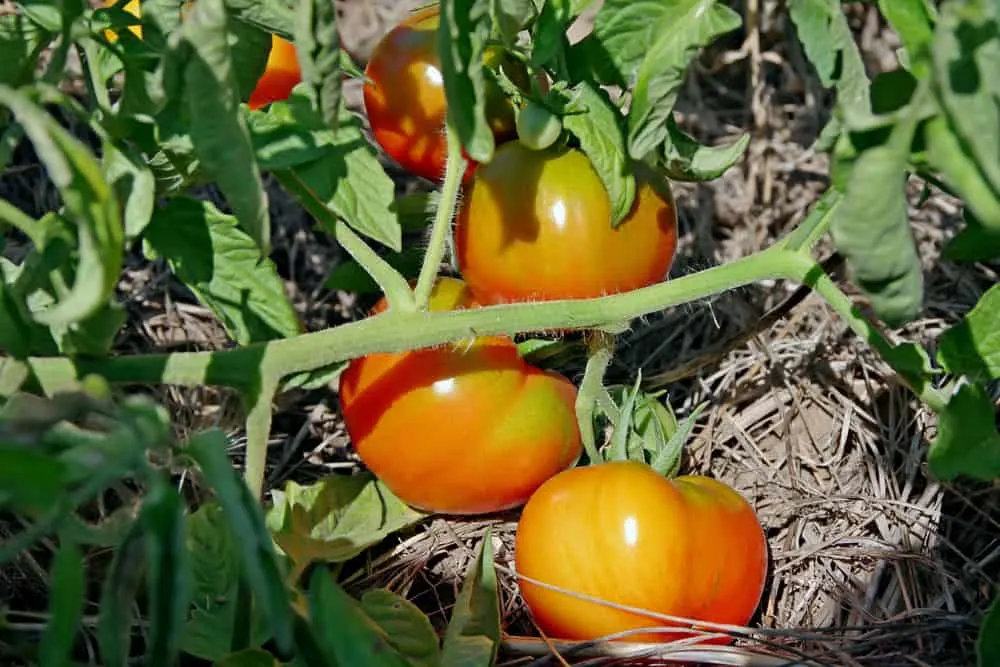
And it doesn’t stop there. Gardeners could go on about the benefits of mulching all day, but here’s a quick-fire round to convince you it’s necessary.
Organic mulching…
- Reduces soil erosion.
- Keeps water off leaves, preventing disease.
- Keeps any fruits that fall to the ground clean and away from the soil, limiting rot.
- Improves the structure of the soil as it breaks down.
- Prevents soil compaction and crusting on the surface.
- Makes the garden more uniform and pleasing to the eye.
Convinced? I thought so. But before you get started, you’ll need to choose a mulching material.
These five organic mulches are ideal for your tomato plants:
5 Best Mulches for Tomato Plants
1. Leaves
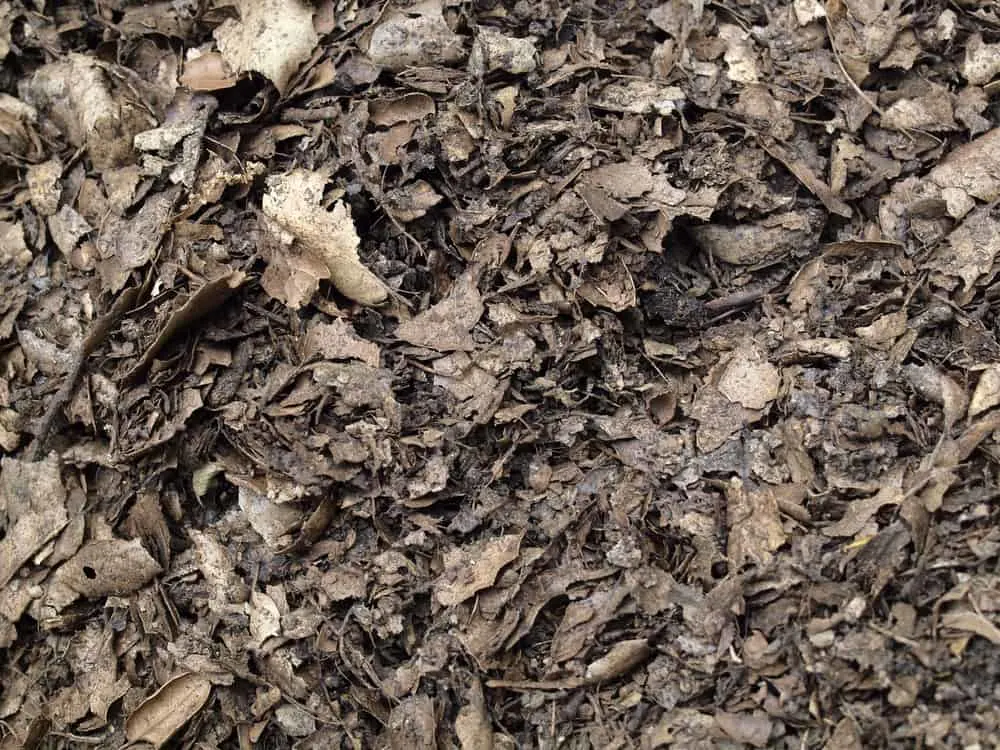
What better way to use the dead leaves you painstaking rake up than to benefit your garden? Shredded leaves are a fantastic mulch. They protect the soil as the plants grow and break down over time to improve soil health.
The word shredded is the key here. Although shredding leaves is an extra step, it is a necessary one. Leaves that aren’t shredded lose all the mulching benefits and can end up damaging your plants overall.
Instead of retaining moisture and improving soil quality, they prevent water and air from reaching the soil, depriving the roots of their basic needs. If the layer is too thick, it can also trap too much moisture in the soil, causing root rot.
There are leaf shredders designed for this exact task, or you can go wild with your mower and ride over your leaf pile a couple of times to do the job.
2. Straw
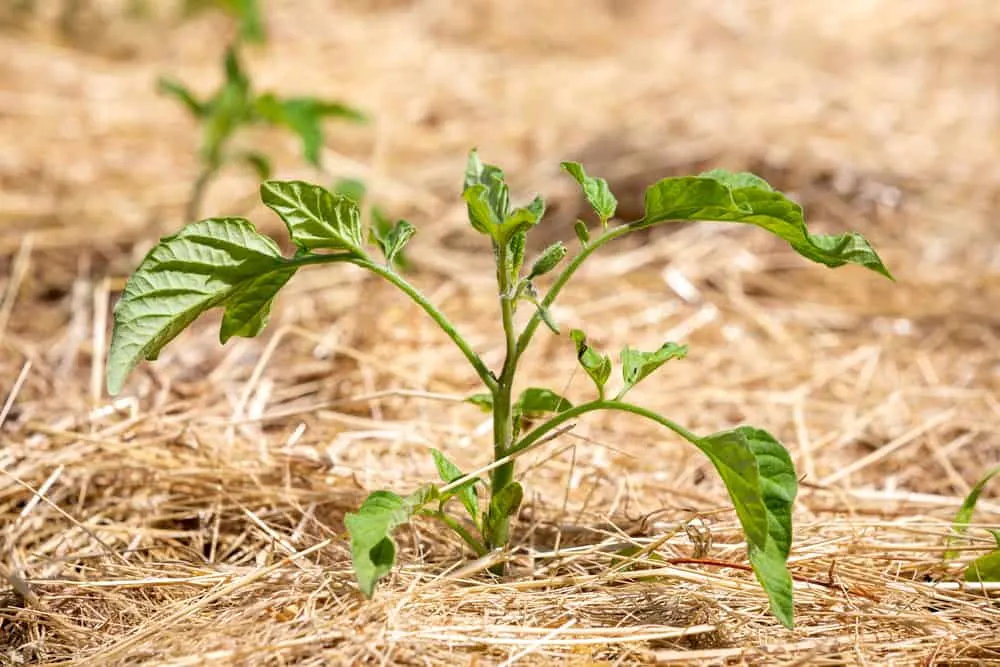
Straw is one of the most popular mulching materials for tomato plants. It is lightweight and also breaks down easily to improve soil structure. You can find straw for mulching at garden centers – rice straw and wheat straw are popular examples.
Avoid using hay as a mulch – it often contains weed seeds that spread to unwanted parts of your garden. The goal of mulch is to keep weeds away, not encourage them.
When purchasing straw, remember a little goes a long way – you don’t want your mulch layer to be too thick. Any leftovers can always be thrown on the compost pile to break down and form the next type of mulch.
3. Compost
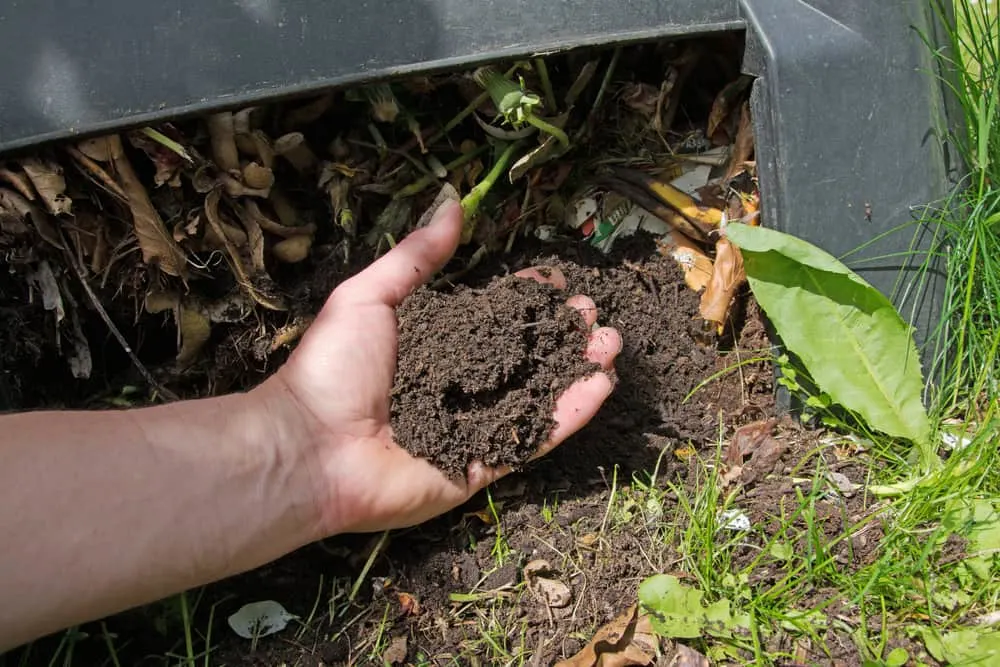
Most gardeners have some compost on hand, whether home-made or store-bought. Compost is used as a soil amendment to improve soil structure and increase the amount of organic material in the soil before planting. But after planting, you can also add another layer on top of the soil as a mulch.
Compost mixes with the soil much faster than other mulches and will need to be replenished more often. But, that also means it will improve the soil faster than other organic mulches that take longer to break down.
You’re likely using compost in your tomato beds anyway. By using compost as a mulch, you’ll complete two tasks in one, saving yourself time and benefitting your plants in the long run.
4. Grass Clippings
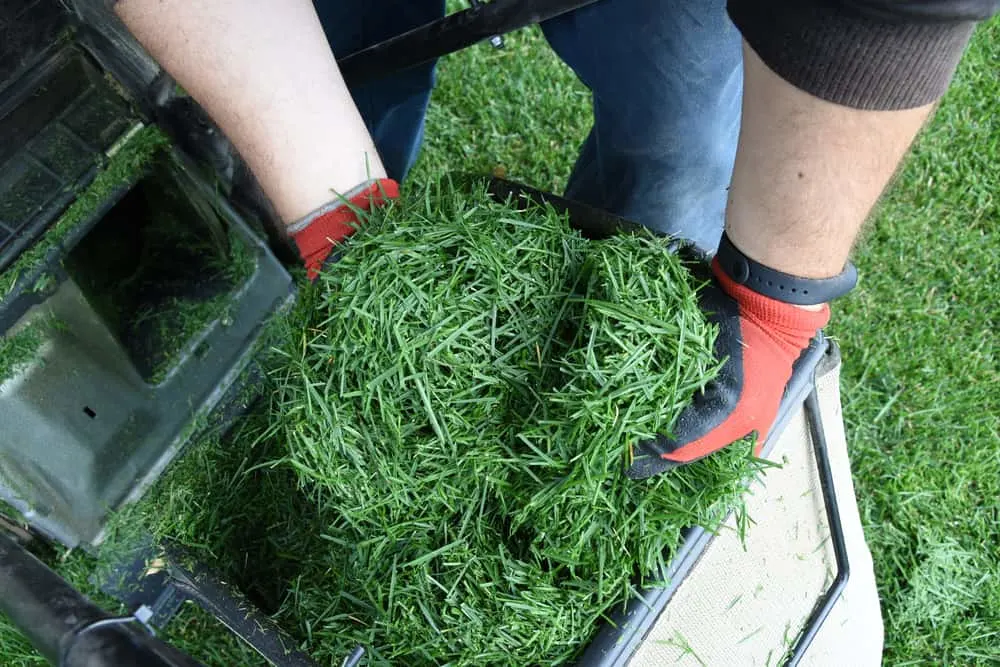
Any gardeners with a lawn will produce piles of mulch as they mow every few weeks. Grass clippings provide an almost endless supply of mulch to suit small or large gardens and are available all year round.
However, that does come with some caveats.
Grass clippings need to be dried before use. Wet grass will stick together and form a carpet on top of the soil, making it difficult for water and air to penetrate it. It also doesn’t smell pleasant when wet – something you won’t want to deal with when out in the garden.
The grass clippings you use should not contain any chemicals or treatments either, as these can have a negative impact on your tomato plants and potentially your health as the tomatoes will no longer be safe to eat.
5. Bark Chips
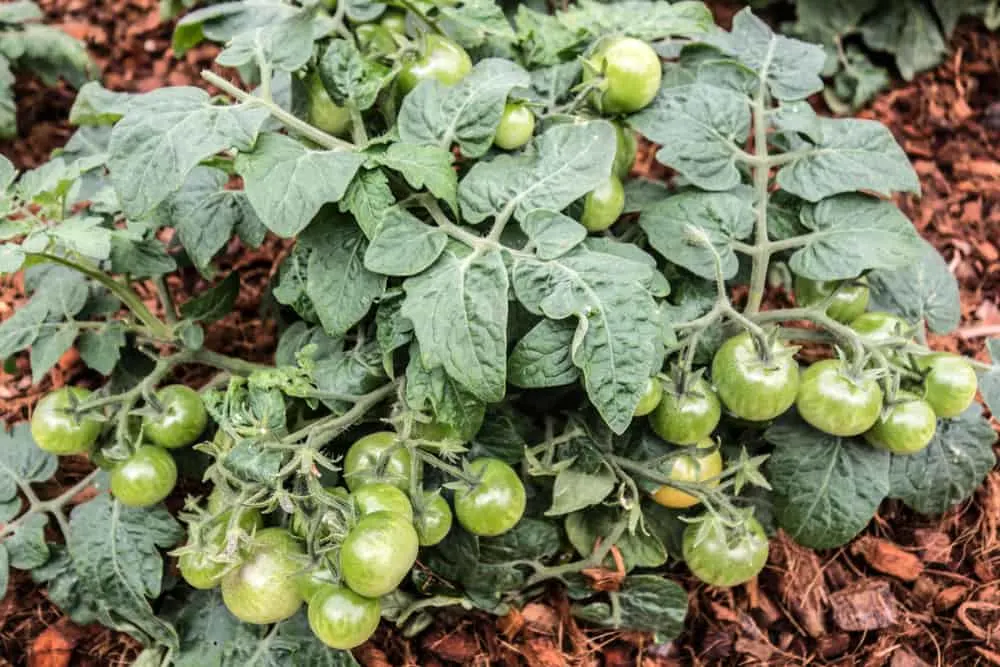
Bark chips are a popular mulching choice for design-conscious gardeners. They are one of the most attractive mulches and take a long time to break down, limiting extra mulching time over the season.
However, this design benefit comes with a downside. Wood-based mulches, like bark chips or shredded hardwood, can change the composition of the soil as they break down. You will need to keep a closer eye on the soil to check for changes in pH levels and use a nitrogen-rich fertilizer to replace what the soil has lost.
Depending on the kinds of bark chips you choose, they can also compact over time and attract fungi and bacteria. It’s best to purchase bark chips made for special use as mulch to avoid any potential problems.
There are several other organic mulches used by gardeners – coffee grounds, shredded newspaper, or cardboard for example – but they can potentially cause more problems for your tomato plants if not properly installed and monitored. These 5 materials are tried and tested mulches and are less likely to give you trouble in the long run.
How to Mulch Tomato Plants
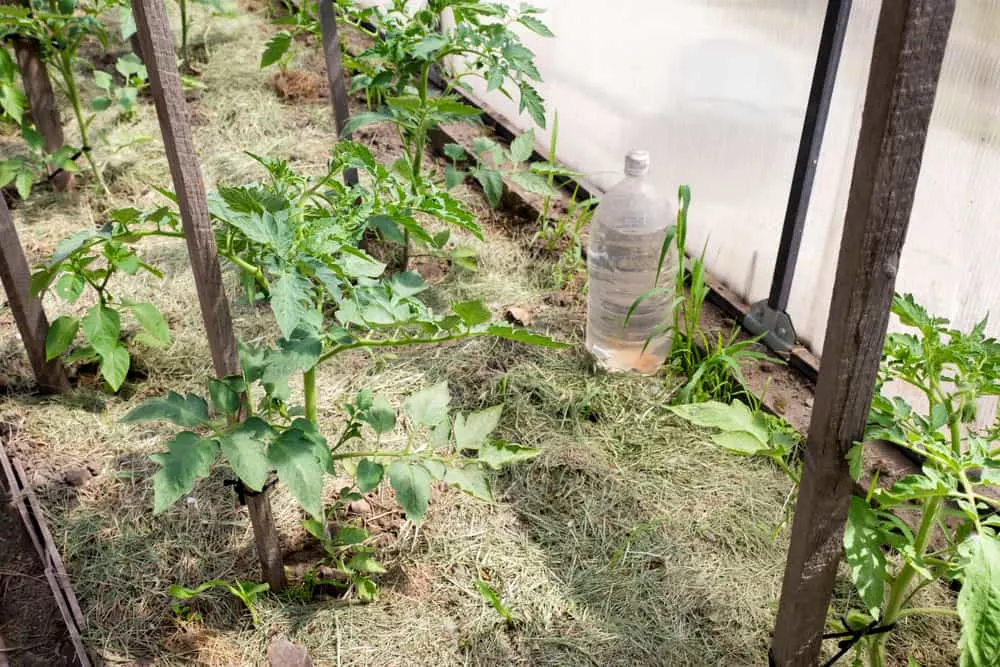
When To Mulch Tomato Plants
Tomatoes love warm soil, especially in the early stages of growth. Start mulching later in spring once the soil has warmed up, but before the temperatures get too high to keep the soil cool enough.
Wait a few weeks after planting before laying the mulch to give the plants a good start in the warm soil. If you lay your mulch too soon, it may delay the growth of your plant if the soil is too cold.
The last thing tomato gardeners want is a late harvest, so make sure you mulch at the right time.
How To Mulch Tomato Plants
Spread a layer of your chosen mulch around the plants around 2 inches thick. If weed suppression is your goal, you can spread the mulch along the entire bed – not just around the plants.
Leave some space around the stems of the tomato plants, ensuring the mulch is not touching the base. If the material is soaked in water, it may cause the stem to rot. Keep any trailing leaves and branches off the layer of mulch too to prevent rotting and disease.
Water thoroughly once you have placed the layer and place your finger in the soil underneath to ensure it has soaked through.
Continue adding layers as the old ones break down into the soil. The time of your next mulch addition will depend on your chosen material and its rate of decay. You can also work the old layer into the soil before applying another one if your plants need a boost of organic materials.
It’s cost-effective. It’s easy to do. And it’s essential for the health of your plants. There’s almost no reason not to use mulch in your tomato garden.
These five organic mulches are guaranteed to provide all the wonderful benefits of mulch. With very little effort from you, your tomato plants will give you a great reward at the end of the season.
